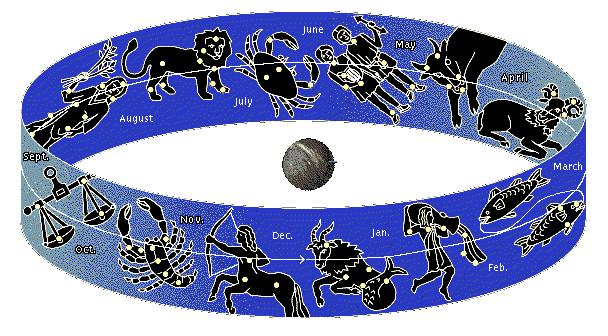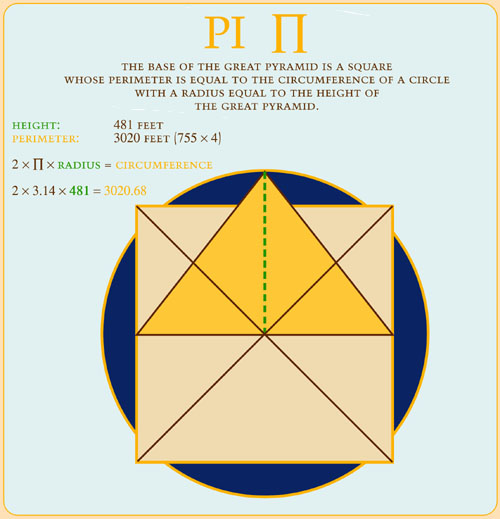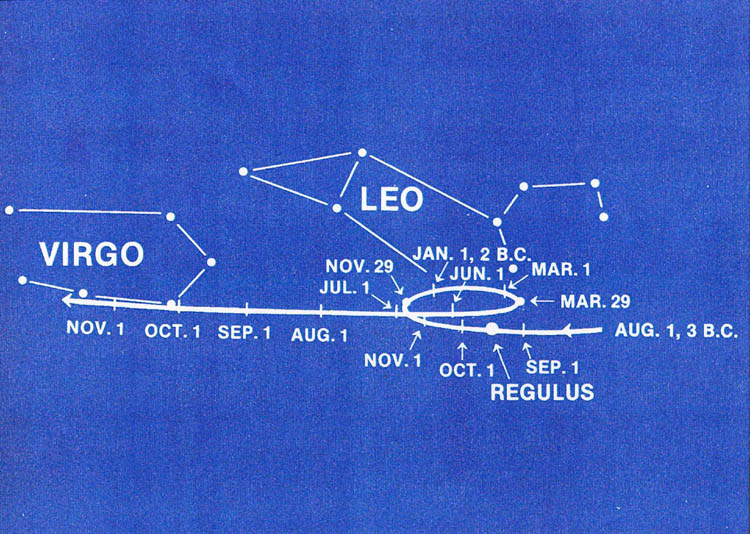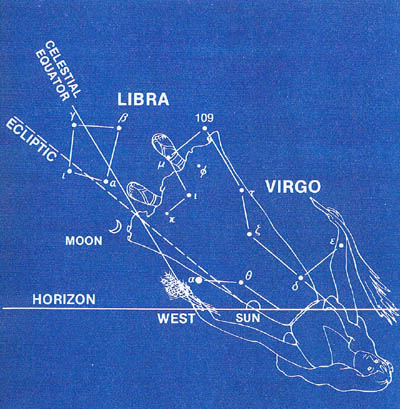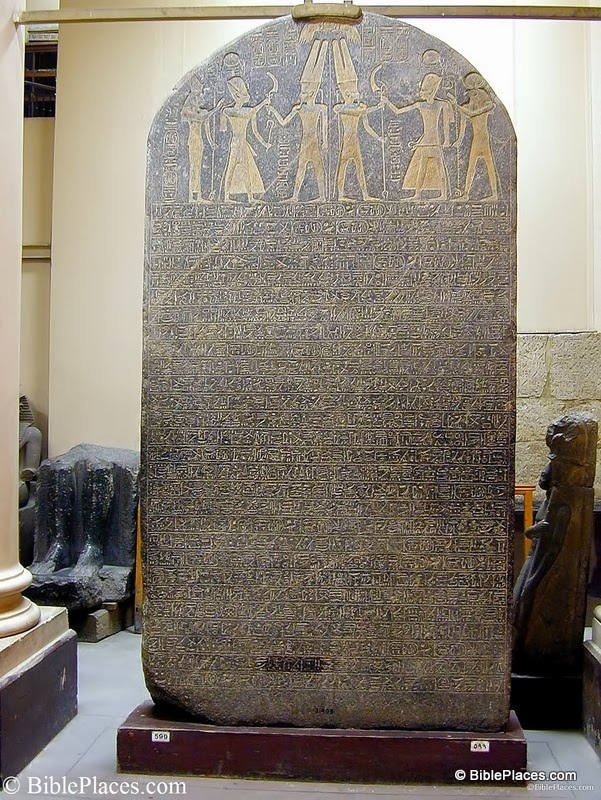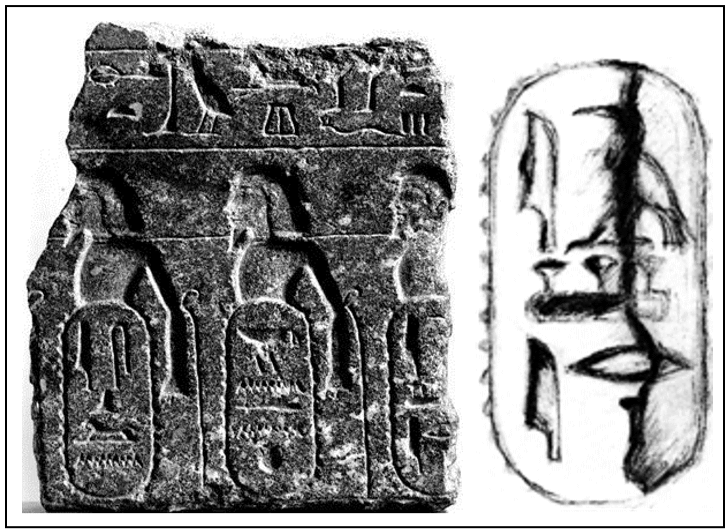
This month’s blog shines more light on the subject of the Celestial Prelude as it relates to the Coma Supernova. There has been a lack of tangible historical evidence surrounding this Supernova in the decans of Virgo, which is the aim of this study to generally remedy. By using mostly ancient sources like the Scriptures of the Bible, and artifacts of ancient archaeology like the Dendera Zodiac, the Great Sphinx and the Great Pyramid, two mainstays of ancient Egyptian Megalithic Architecture, unified using the principles of Biblical Astronomy, we can show how these wonders of the ancients can reveal more of their secrets in answer these questions. Along the way we will continue to unmask the errors of a main critic of the Celestial Gospels; Dr. David Faulkner.
To begin with, Faulkner makes numerous false claims, one of which is “If the Gospel in the Stars was antediluvian as claimed, then there were two millennia to garble the message before any sources that we have regarding the names of stars and constellations.”1 Here Faulkner has his dates confused since historical sources for star names in ancient Egypt are not only found related to the star shafts of the Great Pyramid, but stars named in decans in the Dendera Zodiac, and the Pyramid texts that are all pre-flood references. “Even if the message was kept intact by a remnant unto Abraham and down to Moses, that still leaves a gap of 1000 years. Not only are there no texts preserving the original knowledge of the Gospel in the Stars, but we know of no sources before Rolleston claiming that there ever were such texts, or that any ever lived who believed such things. The first source
we know of to make this claim is Rolleston’s book. To be clear-it’s obvious from Rolleston’s book that she had no texts that clearly taught her thesis. Instead, she created the meanings to support her thesis without reliance upon any older texts. The evidence we have is most consistent with the Gospel in the Stars thesis not being an ancient idea at all, but entirely the invention of Frances Rolleston less than 200 years ago.”2 Contrary to this, studies on the Egyptian star names and their Decans, in the Dendera Zodiac show bonafide historical sources for the existence of these star names and their meanings over 3,500+ years before Rolleston. Biblical sources alone provide extensive evidence in this category, that Rolleston herself referenced in her extensive charts on Hebrew Star names in God’s Word. [Job 9:9, 26:13, 38:31-33, Gen. 37:9-11, 43:33–Joseph, Gen. 49:1-28, Num. 2, 24:5-20 Deut. 33: 5-29, Ps. 19, 147:4 Song of Deborah, Judg. 5:12-20]
Excerpts from “A Further Examination of the Gospel in the Stars” 3
“Rolleston (1865, part 2, pp.104–106) included a section on the Star of Bethlehem. She stated that in about 125 BC a bright star appeared, so bright it was visible to the naked eye during the day. Rolleston also said that this event induced Hipparchus to make his star catalog about the same time. In his work called the Almagest, Ptolemy said it was Hipparchus’ discovery of the precession of the equinoxes that provided the impetus for Hipparchus to produce his Star Catalogue.” 4 We need to take a moment here to recognize the powerful influence that Hipparchus and Ptolemy had on ancient Astronomy, and the involvement of both of these historical stalwarts speaks volumes to the legitimacy of the Coma Supernova.
Both of these giants where eyewitnesses to the Coma Supernova, and if there were two ancient astronomers one could choose to have as witnesses of this event, these two all-stars would surely be on the guest list. Probably one of the greatest (and underrated) astronomers that ever lived, was Hipparchus of Rhodes. He is known to have been active at least from 147 –127BC, making him contemporary to the explosion of the Coma Supernova, as he was a recorded eyewitness to its appearance in c. 134 BC.
Hipparchus of Nicea
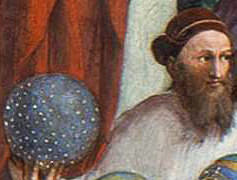
“Hipparchus is considered the greatest astronomical observer, and by some the greatest astronomer of classical antiquity. Most textbooks laud the accomplishments of Aristotle and Ptolemy, yet Hipparchus probably did more for the subject than any other Greek. Most of Ptolemy’s works were based on his ideas, yet Ptolemy is generally given credit because he perfected many of Hipparchus‘ concepts. Below is a short list of some of the accomplishments of Hipparchus:
* Hipparchus invented/developed trigonometry, a branch of mathematics which he used to determine geometric relationships between the earth, moon and sun. The word “tri” (meaning 3) comes from the reference to these three celestial bodies.
* Hipparchus made elaborate sky charts which included 1080 stars. On these maps he invented a coordinate system similar to longitude and latitude on a globe. Each star was given a number (1- 6) based on its brightness. The brightest stars were 1 and the naked eye limit were 6. Our modern magnitude scale is a slight modification of this original brightness scale.
* Hipparchus used data on eclipses to determine that the moon’s distance from us was 59 times the earth’s radius (actual value is 60). This involved clever use of logic and intricate mathematics, beyond the scope of this project. Ptolemy used a different (more direct) technique and arrived at the same number. Most text-books give all the credit to Ptolemy.
Claudius Ptolemy
* Hipparchus determined the motions of the sun and the moon so well that he could predict eclipses within a few hours. He also detected the precession of the equinoxes, by studying sky maps made generations earlier.
* He perfected the sun’s motion along the ecliptic so well that he observed slight irregularities in its speed. At one time of the year it seemed to go slightly faster, at other times slightly slower. Use your SC001 sky charts and pick out a few 10 day intervals along the ecliptic throughout the year. With careful measurements, you are able to see this effect. Why is this important? As we can see how Hipparchus solved this mystery, we will understand how Ptolemy used the same techniques to construct his model for the entire solar system.
*Hipparchus had to account for the irregular speed of the sun along the ecliptic that he discovered. At this time, it was believed that all heavenly bodies were perfect spheres. Not only that, but any sphere in motion must revolve with uniform speed. This is just the opposite to what Hipparchus discovered. He needed to mend this inconsistency, and he did.
Over 200 years pass in Greek astronomy between Hipparchus and Claudius Ptolemy of Alexandria. Ptolemy basically took all of Greek astronomy and summarized it in his great book – The Almagest (meaning The Greatest), consisting of 13 volumes, that became the “astronomical Bible” for centuries. In it, he expanded on all the great works of earlier astronomers and added some “finishing touches” to the geocentric model.” 5
Needless to say, these two stalwarts of ancient astronomy had an incalculable influence on the science of astronomy, and the fact that both of these scientific pillars led the science to opening the recognition of the Coma Supernova, in light of Christ’s birth speaks volumes in history, facts mostly ignored by Dr. Faulkner, who alleges a lack of modern sources.
Faulkner points out, “by Rolleston’s comparison with much later events, such as the “new stars” seen by Brahe in 1572, and with Kepler’s Nova in 1604, today we would recognize the 125 BC event as a nova or supernova. “Indeed, many modern astronomers think that it was a supernova, though not much credence was given to it, because mentions of it come from much later, secondary sources. Rolleston went on to suggest, in an oblique manner as a series of questions, that this star remained bright for many years (into the 2nd century AD), and may have been in Coma (alleged constellation of “the Desired”), and hence was the star that alerted the Magi that the Messiah was born. I find it interesting that she did not clearly state these as facts.”6 [Coma is a decan of Virgo, not a “constellation,” see below. Dr. Danny Faulkner citing problems with Rolleston’s hypothesis in his article continues as follows;
“She [Rolleston] also brought in legends about the star which are attributed to Zoroaster. Rolleston cited Arabian astronomer Albumazar describing the signs and “decans of Virgo with Virgo having two parts and 3 forms, saying in the first decan as the Persians and Egyptians teach-a young maiden arose, a pure and immaculate virgin in Arabic named Adrenedefa, holding in her hand two ears of corn, seated on a throne, nourishing an infant, whose Hebrew name was Ihesus, meaning to save, that the Greeks called Christos, or Christ, rising with the virgin. These figures, found in the Egyptian Planisphere [Dendera Zodiac-Plate 3] with the Virgin holding the ear of corn as Virgo, while Koma may be the original name seen in Coma, marking the Head of the infant, the Desired seed of the Woman. It was said Zoroaster predicted that this star would appear in the figures of the Virgin.” 7
Faulkner also refers to a legend that the Magi came to a well wherein they saw a reflection the star in the well-water, suggests that since this occurred around midnight on the winter solstice, this must have been when the Magi arrived. Notice the endorsement of the traditional date of December 25 for Christ’s birth, something that Rolleston endorses elsewhere, but almost no scholars today believe was the correct date.”8
Here are historic roots for some of the “legends” Faulkner refers to in his criticism of Rolleston’s Mazzaroth.
According to Hislop, the Chaldean version of the word; “Zer,” that mean “to encompass” gives us not only the English basis for: “Zero signified by a circle among the Chaldeans,” but also Zero; “the seed.”9 Further, it relates to the Hebrew word zera [H2233] used referring to the promised seed in Gen. 3:15. 10 To this end the Chaldean word for the “woman’s promised seed” was “Zero-ashta,” that also formed the basis of the name Zoroaster. We take note in Zoroastrian writing in the Zend-Avesta, the predicted return of Zoroaster as a savior who would renew all existence in preparation for the Last Judgment, was prophesied. These references to the woman’s promised seed point directly to what I’ve termed as the General sign of the Celestial Prelude. To sketch this “legend” out further, Hislop also notes:
“In almost all nations, not only was a great god known under the name of Zero or Zer; the seed, and a great goddess under the name of Ashta or Ishta; the woman, but the great god Zero is frequently characterized by some epithet which implies that he is The only One.” 11
This evidence provides a basis for a direct correlation to the decan Coma, the seed who was the desired of the nations, [Hag. 2:7] especially in context of the Coma supernova in the child’s head [pictured in Plate 1. below from the Dendera Zodiac] the promised seed, as the general sign of the Celestial Prelude. The implication that the promised seed of the woman as the only man, who could be the perfect sacrifice for the redemption of mankind, speaks to the truth that Christ is the Alpha and Omega, or the first and last way God made available to redeem humanity. Hislop goes on to say:
“As he who by the Chaldeans was regarded as the great Seed was looked upon as the Sun incarnate, [Ps. 19] and as the emblem of the Sun was a circle, a hieroglyph relating between zero; “the circle,” and zero; “the seed” was easily established.”12 The Biblical references to Christ associated with the Sun incarnate as the “light of the world,” the “Sun of Righteousness” [Mal. 4:2] and in Psalm 19:4-6, are only a few of many such references. Thus, the case of the promised seed, Zero-ashta, the religion of the Magi served as a vessel for numerous principles and astronomical precepts, that led Mankind to the realization of the Promised Seed.
This part of Faulkner’s criticism exposes his lack of knowledge on the birth of Christ, opposed to its traditions. He equates the time of the Magi’s arrival in Jerusalem, with Christ’s birth, when in truth the Magi arrived in Jerusalem, and just after that in Bethlehem, about 15 months after Christ’s birth. This of course is the same error found in the traditions of all the Christmas “manger scenes” showing the wise men at the birth of Christ, no where found in scripture, or true historical records. This fits with our date for the birth of Christ on 9/11/3 BC, for the Jerusalem arrival and afterwards in Bethlehem, in Dec. of 2 BC. The Magi did not find a “babe” [brephos-Lk. 2:12, 16] in a “manger,” but a young child [paidon] in a house [Matt. 2:8-11]. There were also no shepherds present as December was too cold for sheep to be in pasture. Our thesis is confirmed in the research of Dr. Ernest Martin in his book; “The Star that Astonished the World.”13 Faulkner notes that “Rolleston did not cite her sources for some of her work, but did quote from Trench (1850). RC Trench spoke of “this star as so many of the ancients and moderns have done, to have been a new star in the heavens.”14 Rolleston also quoted Trench on the early church fathers, like Ignatius, on the appearance of this star; Coma Supernova. Both Seiss (1882, pp.161—162) and Bullinger (1893, pp.36—39) included like passages about this alleged “new star” as the star of Bethlehem. From their descriptions, it is clear that Seiss and Bullinger solely and uncritically relied on Rolleston in this matter.”15 Fortunately, many other sources have come to the fore since then, on this topic, which we will review below. Back in the late 1990’s when I first broached my ideas on the Celestial Prelude I built on some of Rolleston’s concepts as a basis of the celestial events leading to the Birth of Christ. In the last 21 years my views also developed, improving on the science and Biblical verities that inform this topic of research.
The premise of a Celestial Prelude is based on the simple fact that God would not ordain the long awaited birth of His only begotten son, the eternal purpose of the ages, without a little advanced notice in the sky. This Celestial Prelude has 2 key parts, the first is general the second specific. The entanglement of these two separate parts of the Celestial Prelude has caused much of the confusion surrounding the “Star of Bethlehem.” A good place to start thinking about the first part of the Celestial Prelude is:
Where did the popular idea of a single bright star, obvious to everyone, marking the birth of Christ originate? To answer this question we look to what I’ve termed as the General Sign of the Celestial Prelude, that alerted the Magi to the broad period of time [200+ yrs.] when the promised seed would appear. We will distinguish the General sign of the Coma Supernova, that was unpredictable for astronomers, from the specific signs of astronomy marking the birth of Christ, like planetary unions, alignments, solar and lunar eclipses, meteor showers, comets etc. that are predictable in the context of the science of astronomy. Dr. Henry Morris has marked some of these differences between the predictable scientific basis of astronomy as opposed to astrology.
Their knowledge and conviction that the birth of a Jewish Prince had occurred, that they came to honor and recognize with their best gifts and adoration, showed much more than the expectant masses of the time. Their unique revelation which was established in the appearance of the star over Bethlehem, and in dreams from God showing them the way home to avoid Herod, took place after the fact. Since astrology is strictly forbidden in God’s Word, there is no way God would talk to the Magi if they were astrologers. [Dan. 1:20, 2:2, 27]
As Dr. Morris states; “There is also the very realistic possibility that this new star occurred in one of the constellations which had been associated with God’s primeval promise of the coming Savior. This “protevangel” (that is, “1st Gospel“) prophesied the age-long conflict between the Serpent (or Satan) and the Seed of the Woman (that is, Christ). The Gospel in the Stars began in (Gen. 3:15), with the first prophecy of Christ. This promise reflected in many of the star-pictures of the constellations, especially the twelve signs of the Zodiac and their decans. While these stellar messages have been badly corrupted by astrology, they do predate any astrological meanings later imposed on them. In fact, the Scriptures themselves imply that these pictures and their primeval meanings were established originally by God Himself, through the ancient patriarchs (Seth in particular, according to the Jewish historian Josephus). He wanted to imprint His purposes and promises on the very heavens themselves, so they could be seen in all times and nations, especially before His written Word would become available. Thus, “the heavens declare the glory of God” and have been uttering speech and showing knowledge day and night throughout the world” (Psalm 19:1, 2), ever since the beginning.
In this regard we find references to a prophecy of Seth–Adam’s righteous son, that at the birth of the Promised Seed, a very bright singular star would herald his arrival. This new star that manifested in the decans of Virgo, was so bright as to be visible to the naked eye in the daytime, was seen by the Church Fathers of the period. The Magi’s faith in the true God of creation and the promises in His Word, undoubtedly familiarized them with the original signs and symbols God had imposed on the stars, and thus were able to recognize that this new star that had suddenly blazed forth in the sky must indeed be “His Star,” announcing the birth of the promised King.” 16
As Dr. Morris tells us; “There does remain one special type of star which is free from astrological associations, these are the novas (formerly called “new stars“) or, still more intriguingly, the rare supernovas. These real stars, are separate and apart from conjunctions of stars [planets], or comets, certainly not atmospheric phenomena. Supernovas, are sudden, rare, entirely unpredictable explosions of existing stars that had been originally created on Day Four of Creation Week.”
Somehow what seems to be an ordinary star suddenly increases tremendously in brilliance, continuing so for varying periods until it finally fades out of telescopic or naked eye visibility. “As a matter of fact, there may well be certain other hazy records of such a star. In the Bible, the only mention of the star is in Matt. 2:1-12. However, a number of the early Christian writers were fascinated with the account, and apparently did some contemporary research of their own, in extra-Biblical sources. Here is Dr. Morris’ recognition of the Coma Supernova by Ignatius; 17
“For example, Ignatius, who was the apostolic father closest in time to the New Testament writers (died 107 A.D.) wrote of the star as follows: “(It was) a star which so shone in heaven beyond all the stars, its newness caused excitement.”18
Rolleston’s reference to Ignatius, one of the Church Fathers and the Bishop of Antioch, in about 69 AD, records that, “At the appearance of the Lord a star shone forth brighter than all other stars.”19 If we are careful not to confuse this Coma supernova reference with the planet Jupiter, we find evidence of a supernova still visible over 200 years after it was first seen as a celestial marker of the general timeframe of Jesus’ birth. Seiss has some viable historical references on this point:
“Hipparchus about a hundred twenty-five years before Christ, [c. 128BC] observed it [Coma supernova] as a new star, and was led by it to draw up his catalogue of stars. Ptolemy, about one hundred and fifty years after Christ, refers to it as having been observed by Hipparchus, but as having become so faint [c. 147 AD] as hardly to be any more discernible.”20
Pliny the Elder wrote in 79 AD that Hipparchus suspected the fixed stars were not as fixed as other people thought. After all, Hipparchus had seen a new star in Coma appear from nowhere. He first recorded precession of about 1 degree a century. 21 A point of interest here regarding Hipparchus is that he is generally credited with the discovery of the precession of the equinoxes, by modern science said to be c. 134 BC. He reportedly came upon his discovery studying the star Spica, on a celestial map from his predecessor, Timocharis. He noticed that Spica was about 2 degrees away from its location on the star map, and decided that it was moving an average of 1 degree every 75 years: [close to the actual 72 years]. “Hipparchus began to wonder if the ‘fixed’ stars might move relative to one another. If so, constellations may change their shapes over time, a fact he hoped his star catalog would help future astronomers discover if true. This is a well-known fact in modern astronomy, called the proper motion of stars, that was discovered by Edmund Halley in 1718 of Halley’s Comet fame, when he noted the movement of the stars Sirius, Arcturus, and Aldebaran compared to the positions in Ptolemy’s catalog. This stellar movement was independent of precession.” 22
The decan of Coma is pictured below as the three bright stars forming the inverted “L” shape, which significantly contains the North Galactic Pole, located 5 degrees west of Beta Coma. This bears a closer look in light of the original star picture associated with this decan, as seen in the Dendera zodiac, of a mother holding her Son in her lap, known as “the Desired of the Nations,” [Plate 1 below]. The close proximity of the Northern Galatic Pole, recalls the imagery of Cepheus “the crowned king” regally seated astride the Celestial Pole star polaris, picturing Christ seated in the heavenlies at the right hand of the Heavenly Father, [Eph. 1:20-23].

The Stars of the “L” shaped Decan Coma. 23
During this proposed 250 year period between c. 128 BC-147 AD referred to by Ptolemy above, shekels from Judea struck during the period of the second revolt, [132 AD.] bear the image of a bright star over the Jerusalem Temple, called Bar Kaukab, or Son of the Star. As this star was seen to be vertical over the Temple in Jerusalem, and Bethlehem, as Coma was known to be, so it was recalled on this temple coin. This could have also been a logical reference to a supernova appearing in the head of the woman’s son in Coma‘s lap, the desired of the nations, that would still have been visible to the naked eye, perhaps even a celestial reference to Jesus as the true temple.
The Magi would have witnessed both this new star shining brightly in Coma, a decan of Virgo, while Jupiter was in retrograde, standing still on the Meridian in Virgo, in December of 2 BC. The General sign of our Celestial Prelude thus overlaps the Specific planet signs, as the Magi headed south from Jerusalem, their visit with Herod just concluded, towards Bethlehem in search of the promised seed. This also explains why the Magi were the only group to recognize these specific celestial signs of the Messiah’s birth, because the General sign was a fixture in Coma for over a century prior to this period. The typical person wouldn’t have noticed anything out of the ordinary in the heavens, since it would not stand out unless coupled with the knowledge of the specific signs, which brought the Magi to Israel in the first place. This is another reason why the Magi were so joyful when they saw “his star,” Jupiter over Bethlehem. This scenario of what the Magi beheld in the skies over Bethlehem in December of 2 BC, is depicted in the title banner of this article above. In Num. 24:17, when Jacob is referred to in Balaam’s prophecy, it bears reference not only for the seed of Jacob, but also in the land promised to him as an inheritance, in his covenant with God [Gen. 15:18]. Rolleston has a noted remark regarding this:
“The Magi forewarned that the star must appear over Jacob, over his inheritance, would see that star in Coma passed over the center of that inheritance: but as it would also appear to pass vertically over every part of it that was nearly in the Latitude of Jerusalem, they could not at once fix on the spot of the Messiah’s birth, therefore they went to inquire; the Latitude, as it were, being given by the star, the longitude by the prophecy.“24
Here we see the witness of the stars, and the Scriptures, working together to bring the Magi to the toddler Jesus, because their alert observation of “his star” brought them to Jerusalem and the scribes declaration from Micah 5:2, when Herod questioned them, sent the Magi to Bethlehem. While en route they witnessed the heavens come alive with the proof that their historic journey was not in vain, because they saw both the Coma supernova, and Jupiter in Virgo in the same skies over Bethlehem, marking the savior’s location.
In Faulkner’s criticism of Rolleston, he fails to acknowledge Dr. Ernest Martin ‘s and other’s extensive research on this topic, showing his short-sited approach to this important history. Although the key contributions of Seiss and Bullinger to the topic of the Gospel in the Stars are important, they are not the sole authorities referred to in this area. Based on this faulty and myopic view of history, Faulkner questions the credibility of this explanation of the Star of Bethlehem, as follows; “Unfortunately, it is not credible. First, a nova or supernova is not readily visible for years. A nova is bright for a few days, but then quickly fades away.”25
Here Faulkner also overlooks or discounts a very real probability, as presented by Dr. Hugh Ross of the various types of nova’s/supernova’s including Recurrent Supernova’s, which we will see more on below.
Dr. Henry Morris refers to some extra-Biblical references as the writings called The Protoevangelium of James, quoting the wise men as saying to Herod: “We saw how an indescribably great star shone among these stars and dimmed them so that they no longer shone, and so we knew that a King was born for Israel. Eusebius, a scholarly church historian of the early fourth century, evidently made a considerable study of literature available from the centuries before him, and came to this conclusion about the star.”26
“Let us now learn the reason why the star appeared, according to the agreement of prophetic prediction with Gospel fulfilment. Moses says, that all the stars were set in the firmament by God “for signs and for seasons.” But this was a strange and unusual star, not (d) one of the many known stars, but being new and fresh by its appearance here it portended a new luminary that should shine on all the Universe, the Christ of God, a great and a new Star, whose likeness the star that appeared |153 to the wise men symbolically shewed. For since in all the holy and inspired Scriptures the leading object of the meaning is to give mystic and divine instruction, while preserving as well the obvious meaning in its own sphere of historical facts, so the prediction before us was properly and literally fulfilled in the matter of the star that was prophesied to appear at our Saviour’s Birth.
In the case of other remarkable and famous men we (420) know that strange stars have appeared, what some call comets, or meteors, or tails of fire, or similar phenomena that are seen in connection with great unusual events. But what event could be greater or more important for the whole Universe than the spiritual light coming to all (b) men through the Saviour’s Advent, bringing to human souls the gift of holiness and true knowledge of God? Wherefore the herald star gave the great sign, telling in symbol that the Christ of God would shine as a great new light on all the world.
And the prophecy foretells a man as well as a star, for it says: “A star shall rise out of Jacob, and a man shall spring from Israel,” naming first the heavenly light, the Word of God, and next the Humanity. And He is called, as I have shown in my former books, in other places by the varying names of Rising, Light, & Sun of Righteousness.
And here, by applying to Him the verb from “Rising,” “a star shall rise out of Jacob,” it shews his divine aspect, as “giving light to every man that comes into the world“; while it shews the Humanity, by the suffering that comes to him, where it foretells that He will fall to rise again, in words like what Isaiah says of Him: “And there shall be a root of Jesse, and he that shall rise to rule the Gentiles; in Him shall the Gentiles |154 trust.” And we see how true it is that the light of our (d) Saviour, which rose from Jacob, that is from the Jews, has shone on all nations but Jacob, from whence it came forth.
And while this can be found in many prophecies, which say as it were to Christ himself: “Behold, I have set thee for a light to the Gentiles, for a covenant of thy race,” it is especially obvious in the words of Balaam, when he says: “A man shall come from his seed, and shall rule many nations.” Whose seed but Israel’s, as the context shews?” 27
A recent writer, Robert McIver, has spent 3 decades researching this subject. In his book, Star of Bethlehem-Star of Messiah, published 1998, he cites star records from ancient Chinese and Korean astronomers who both noted such an unusual new star about the time of Christ’s birth. He also discusses paintings in the Roman catacombs, as well as coins from various countries which depict an unusual star about this time. He even notes possible sightings of the star in the Americas. Much of his evidence is open to other possible interpretations, but it is an interesting coincidence, if nothing else, that such indications of an unusual new star about the time of Christ’s birth are found all over the world.
“In any case, it does seem that the most feasible explanation for the Christmas star is that it was a real star, other than either a conjunction of two or more stars or a special moving light of some kind in the lower atmosphere. After all, the Magi called it a star, and they would surely know the difference.”28 Of course the ancients during the times of the Magi and later referred to planets as “stars” also, not making the distinction of “wandering stars” until much later.
They were almost certainly acquainted with the of the Old Testament, especially Balaam’s prophecy of a new Star which would signal the rising of a great King in Israel. Balaam himself was probably a member of the Magi, perhaps even the founder of their caste. Zoroaster also was probably one of the earlier Magi, between the times of Balaam and Christ.
Thus it is significant that both Balaam’s divinely inspired prophecy and Matthew’s divinely inspired history recognized it as a star? In fact as “His” Star! Unless God created a brand new star at this time, which is possible, of course, the most realistic explanation is that it was either a nova, or (more probably) a supernova? A gigantic explosion of an existing star. 29
As noted before, this was the conclusion of the late British astronomer, E. W. Maunder. He simply called it a “new star,” the terms nova and supernova not yet having come into use in his day. In a more recent scientific article, “The Star of Bethlehem,” published in Science Digest in Dec. 1976, James Mullaney says: “The considered opinion of nearly all who have studied the question that a nova or supernova seems most likely explanation for the Christmas star of all those put forth to date” (p.65). 30
Mullaney makes the cogent observation: “Truly, here is a celestial announcement card above all others worthy the birth of a king“.) 31 A supernova explosion radiates more energy at its peak than all the stars in our own galaxy combined! The entrance of God’s only begotten Son into God’s creation, the perfect man among men would surely warrant the most majestic announcement possible in His creation. An angelic host announced it at the scene? A mighty star to the rest of the world!
Dr. Henry Morris continues; “The later Magi, especially those in Babylon and Persia (where Daniel’s influence, as well as Mordecai and Esther) was profound and enduring, was surely familiar with this prophecy as with the various prophecies of Daniel (who was a most highly respected “wise man” in Nebuchadnezzar’s courts, [Dan. 2:45; 6:28]. The Persian Magi in particular were known as very competent observational astronomers, not astrologists. If they were not Jews or Jewish proselytes (both good possibilities), they were Zoroastrians, and the Zoroastrian religion was similar to Judaism in many ways, among which was an aversion to astrology.
At the time of God’s great deliverance of the Jews in Persia during the days of Queen Esther, it was recorded “many of the people of the land became Jews” (Esth. 8:17). This event in itself would constrain many of the Persian members of the Magi at that time to study the Jewish sacred books, like the Messianic prophecies of Daniel. This history would have been a basis of the Magi’s required learning, handed down through the generations, to the time of Christ.
Among the prophecies of Daniel, during the reign of Darius the Mede, was the great prophecy of the “seventy weeks,” which revealed that the Messiah would come as Prince of Israel 483 years after the Persian emperor gave a commandment to the Jews to rebuild Jerusalem (Dan. 9:24,25). It was a distinct possibility that the Persian Magi, as the date approached, put these prophecies of Balaam and Daniel together, as they watched for “His star” to appear.” 32
Since supernovas are very rare and generally unpredictable, they bear no astrological import. There have only been a few visible supernovas reported in our galaxy, Some of the oldest of which includes Supernova RCW 86, seen below.
Supernova RCW 86: The oldest recorded Supernova
In modern times, astronomers have rediscovered the remains of this dead star. Their studies have revealed Supernova RCW 86 happened after a neighboring star offloaded huge amounts of its own matter onto a white dwarf; essentially a stellar corpse. This led to what astronomers call a Type Ia Supernova exploding some 8,000 light-years from Earth. 33
SN 1054: The Crab Nebula
On July 4, 1054 A.D., as reported by Chinese astronomers all of Earth was treated to celestial fireworks as a new star appeared in the constellation Taurus the Bull. The supernova – initially brighter than the Moon–slowly faded away over the course of two years.
Today, amateur astronomers still regularly view the supernova remnant, now known as the Crab Nebula. Researchers suspect it most likely formed from a Type II supernova, which happens when a lone massive star explodes. 34 But there is a great disparity in detecting these Supernova remnants from the total number of Supernovae that have taken place in history, a category that includes the Coma Supernova.
Faulkner states, “in 1975 I independently “discovered” Nova 1975 (V1500 Cygni). For one night, it was one of the brightest stars in the sky, but it faded from view within a week. A supernova stays bright longer than a nova, but it too fades. For instance, the 1054 supernova that produced the Crab Nebula was visible during the day for a few weeks, but it completely faded from naked-eye view after 14 months. Therefore, I seriously doubt that an alleged nova or supernova could have been visible for as long as Rolleston claimed (over a century).35 Faulkner here, overlooks the likelihood of a Recurrent Novae. Recurrent novae – are “defined as systems with more than one recorded nova outburst. There are few members of the Recurrent novae subclass: at this point in research, just ten,” one of which [RS Oph] has a documented history of at least eight multiple outbursts, from 1898 to 2021, a 123 year period.36 Recurrent novae repeat the nova process approximately every 10 to 100 years, while nova outbursts are thought to repeat on much longer timescales of potentially over 1000+ years.
Figure 1. The Recurrent Nova RS Oph. 37

RS Oph about 5,000 light-years away in the constellation Ophiuchus. In its quiet phase it has an apparent magnitude of about 12.5. It has been observed to erupt in 1898, 1933, 58′, 67′, 1985, 2006 and 2021, reaching a magnitude of about 5 on average. 38
If the Coma Supernova was recurrent for a period of about 250+ years, from c. 128 BC to about 147 AD, it would explain the sequence of events described in history according to modern scientific evidence, with the reputable references we have cited. Ancient records only record naked eye-visibility of the Coma Supernova, not potential fluctuation due to multiple eruptions of a Recurrent Supernova, that I’m aware of. As we find in Figure 1 above, the effect of the supernova eruption described in the extra-biblical source attributed to James, as “a great star shone among these stars and dimmed them so that they no longer shone…” is indeed evident resulting from the Oph Recurrent Supernova, adding weight to this hypothesis.
What were the history and traditions that brought the Persian wise men/Magi to Jerusalem in recognition of the birth of Christ? In the modern world, the details of what causes new stars to appear, or stellar explosions of supernova’s with their after-effects are obviously not as obscure scientifically as they once were, and these star explosions are much better understood than even in the recent past. The Coma Supernova would have been evident to many in the head of the young child in the woman’s lap in the Zodiac of Dendera.
Plate 1. The Decan Coma adjacent from Virgo, in the Dendera Zodiac. 39
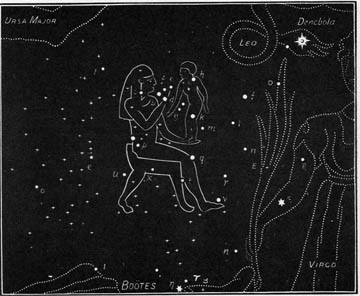
Since the graphic of Virgo’s Decan of Coma from Bullinger, is documented from the ancient Egyptian Dendera Zodiac, we find some of the ancient source texts that not only far predate Rolleston by over three thousand years, but also predate the Greek corruption of this decan of Virgo, to what we have found pictured in this decan for the last 2000+ years into modern times, that the Greeks erroneously called Berniece’s Hair, in their mythology. “The Hebrew word for “Coma the desired” related to the Greek word for hair; “Co’-me,” so her wig [Plate 2.] replaced the longed for, the image of he who was the “desired of all nations,” seen also in the Egyptian name-Shesnu for Coma, meaning the desired son!” [Ps. 19: 10, Isa. 53:2, Hag. 2:7]. 40
Plate 2. Berniece’s Hair adjacent to Virgo replaced Dendera Zodiac Decan of the Woman with her son, seen in the Rev. 12 sign on August 27th, 70 AD: with a Jupiter-Venus union in Leo’s hind paw. 41

How, then, did Balaam know about the Coma sign that would occur at the time to mark the Messiah’s birth, some 1400 years in the future? As all prophets previous and since, reluctant or not, are moved by divine revelation, [Num. 24: 16] which is God making Himself known to His people. Balaam’s reluctant, but divinely inspired prophecy, revealed that a unique Star out of Jacob-linked with Israel would accompany the future Sceptre (King planet Jupiter], Num. 24:17-19), as the redeemer of the world. This is a first usage of the word for “sceptre” in Gen. 49: 8-10, in the prophecies of Judah. These verses of the Celestial Sphinx refer to the Alpha & Omega signs of the Mazzaroth; Virgo the virgin & Leo the Lion of the tribe of Judah. [Lk. 1: 78 dayspring=anatole] With Berniece’s wig/ Coma set between and above Virgo and Leo, in Plate 2 above it calls attention to this key section of the ecliptic.
Gen. 49:8-10 breaks down the maturation of the Lion of Judah, from lion cub, to adult Lion, to aged Lion. The specific relationship of this prophecy with the triple conjunction of Jupiter-Regulus in 3-2 BC was first presented as part of my DVD Seminar on the Biblical Astronomy of the Birth of Christ, in the segment provided below.
As we just saw in the video above, the prophecies of Balaam in Num. 24:16-19 corresponding to the Jacob’s prophecies in Genesis 49, because they not only both deal with Jacob’s star in Israel in general, but they prophesy of the man and Promised Seed-man Jesus Christ specifically.
As we note in the relief from the ceiling of the Temple of Esneh [Plate 3 below], the stellar figures of Virgo and Leo unified in the Great Sphinx, pictured with the solar disk crowning the head of the woman– “sun clothing Virgo,” who is joined with the body of the Lion’s extended claws, above the serpent Hydra. This stellar image seen in the same temple site housing the Dendera zodiac, provides archaeological evidence, for the union of Virgo and Leo affirmed in the two stellar aspects of the earth’s oldest carved monument of the Great Sphinx.
Virgo is seen at the far right below, prominently holding her grain stalk, or branch as shown in the zodiac of Dendera symbolizing her bearing the promised seed and the light of the world. Her branch represents the Alpha Star of Virgo-Spica-Al Zemach, the branch or offspring of God the Father, [Jer. 23:5].
Plate 3. Sun in Virgo, in the Temple of Esneh in Egypt. 42
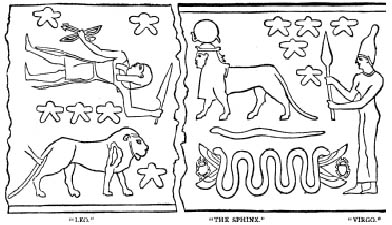
The union of the ends of the ecliptic in the Great Sphinx, with the Sun in Virgo, as seen in Egypt’s Temple of Esneh.
This sets the basic context of the original function of the Great Sphinx, including:
- The unity of the Biblical zodiac which starts at Virgo and ends in Leo.
- The original role of the Sun in this context of “clothing Virgo,” along with embodying the solar aspects of the Sphinx as the Sun of Righteousness, as it moves through the 12 Mazzaroth signs during the year, [Ps. 19].
- A Stone monument bearing parallel witness to the coming redeemer found both in the Stars and in Scripture.
With this in mind, lets look at some specific stellar aspects of the Great Sphinx. A key indicator of the central importance of these stellar traits of the Great Sphinx, is our recognition of the Celestial Sphinx, seen below, in Virgo and Leo the lion providing the basis of signs of the triple union of Jupiter-Regulus in Leo, in 3 BC linked to Gen. 49. This also ties the Great Sphinx both to the Celestial Gospel and Scripture, in their unified testimony of the Coming Promised Seed, starting with the 1st Jupiter-Regulus union, 3 days after Christ’s birth on Sept. 14th, 3 BC.
Plate 4. The Celestial Sphinx. The Head of the Woman and the Body of the Lion as seen on Sept. 14th, 3 BC, 3 days after Christ’s birth on 9/11/3 BC on the eastern horizon from Jerusalem forming the Great Sphinx, marking the first Jupiter-Regulus Conjunction in Leo. 43
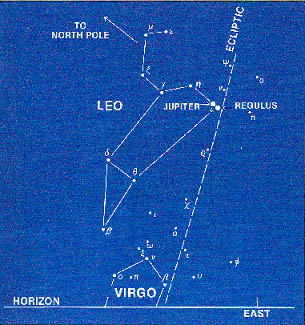
In addition to marking the Alpha and Omega of celestial canon, these signs of the Great Sphinx not only mirror the binding of Scripture together from Genesis to Revelation, presenting Her Promised Seed as the unifying subject in every book of the Bible, starting with Jesus as the Lion of the tribe of Judah in both Gen. 49:8–10, and Rev. 5:5, and Rev. 12, the first and last books of the Bible, but they also prophesy of the Age of Pisces seen in Axis E of the Dendera Zodiac, [Plate. 5] wherein we dwell today, extending from the star Spica-the branch and offspring of God through the sign of both fish of Pisces, that opened the Piscean Age with the Jupiter–Saturn triple union in Pisces in 7 BC.
Plate 5. Axis E on the Dendera Zodiac. 44
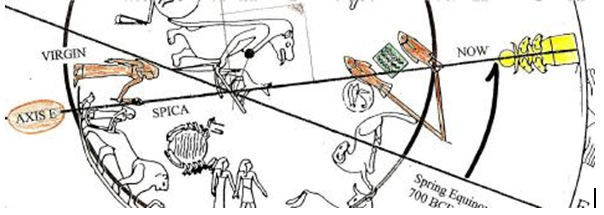
The heavens declared Jesus’ arrival with the setting of the star Spica, Virgo’s branch on our Sept. 11th, of 3 BC, between the setting Sun and Moon in Virgo. This established in the 5th Axis of the Dendera zodiac, Axis E in Plate 5, above, dividing the zodiac while extending below the standing woman–Virgo, holding her grain stalk mirrored in the seated woman, with her child Coma, [Fig. 2 below]. The color-coded image of the Dendera Zodiac in Fig. 2 below, shows how the decans of the middle yellow and outer tan ring of this zodiac, match up with the 12 main constellations in magenta, orange, blue, and Yellow. Specifically, as we view the magenta signs, we find Virgo in the sky blue band, the 2nd ring from the center of this target above Coma in the yellow middle band seated below Virgo’s grain stalk, between Virgo and Leo, the lion’s tail, being one of four main signs of the zodiac of the Cherubim. These 4 Cardinal Directions, of the Hebrew Mazzaroth are a template for the 12 major constellations of the zodiac both in Egypt and Israel. [Num. 24:7–9]
Figure 2. A color-coded image of the Dendera Zodiac. 45
This color coded image of Dendera’s Zodiac adds to our understanding of Axis E in the Plate 5 graphic above, since the location of Axis E labelled below Virgo’s erect standing image in the sky blue band, fits the place where Coma is found on the yellow band under Virgo, aligned with Axis E. Thus we can see how Axis E links Coma and her Son with Virgo’s branch, prophesied to appear near the opening of the Piscean Age, seen in Axis E extending through both fish of Pisces, at one end of the Axis E, to Coma with the supernova appearing in the head of the child in her lap, at the other end of Axis E. See [Plate 5, above].
The image consistent with the path of Axis E on the Dendera Zodiac matches the image in [Fig. 3] below focused on the Great Pyramid embodied in the small white triangle at the center of this graphic. This image shows two Pyramid shaft alignments, one [dotted line] from the Pyramid’s Ascending Passage that aligned with the Conjunction of Venus and Regulus, king star-in the heart of Leo, on Sept. 20th, 2017. The 2nd alignment [solid line] from the Pyramid’s base with the Sun in Virgo, on Sept. 20th, 2017 extends through and beyond Virgo’s body, unites in her first decan Coma, like the image found above in Fig. 2 with Axis E on the Dendera Zodiac. This image of the 2nd alignment with the base of the Great Pyramid, shows the horizon from the Giza Plateau aligned with sunset in Virgo, and Coma, where the General sign of the supernova was bright shining, while the Specific signs of the Jupiter-Regulus conjunctions followed by the Jupiter-Venus conjunctions occurred in 3-2 BC.
Figure 3. The Blood Moon Tetrad and the signs of 2017. 46

Jesus as the Seed of the Woman was the perfect sacrifice for all mankind on Passover. He was the ear of grain that had to die so that life would abound. The Brightest star in Virgo– Spica in Hebrew is Zerah, meaning “seed”–the off-spring of God, the same word found in Gen. 3:15 as the first prophecy of the Promised Seed. Thus, with the Jupiter-Spica triple union that took place in Virgo’s womb in 2017, leading to the birthing of Jupiter, was a sign warning of Jesus’ return when this Great Pyramid sign occurs again in 2028, [or 2047] the 2000-year anniversary of the Crucifixion and Resurrection of Christ. This graphic of Great Pyramid alignments is enlarged below in Fig. 4, to include a 3rd Pyramid shaft alignment at the Christ angle of the Descending Passage, with Jupiter lower in Virgo’s womb in 2017.
Figure 4. Kings Chamber Star Shaft and Descending Passage Star alignments on Sept. 20-21, 2017. 47
On Rosh Hashanah leading to the Rev. 12 sign on 9-23-17, these shafts and passages built in the Great Pyramid exhibit astronomical alignments on the date prophesying, and witnessing to Jesus Christ. As these Pyramid alignments take place in the signs of Virgo and Leo, they qualify as signs of the Celestial Sphinx as seen in Plate 4 above. These are a special class of star signs that speak to the birth and return of Jesus Christ, as separate confirmation, of both the Celestial Sphinx and the astronomy of the Great Pyramid shaft system. We also find the horizon alignment of the Great Pyramid extending through Virgo, to the Coma decan on Rosh Hashanah. This reveals back in the time of inspired construction of the Pyramid, that its unique shaft system, found only in the Great Pyramid had a special purpose, that unified the Coma Supernova leading to the Bethlehem star. Even as the birth of Christ was prophesied by the Great Sphinx, and the Dendera Zodiac, so also the Great Pyramid provides an even greater witness to Christ, as Isaiah prophesied in [Isa. 19:19-21, Jer. 32:20-23]
God included a special heavenly sign linked to the Great Wonder of Rev. 12, in our day. If we back-track, 1260 days from the Rev. 12 sign, we conspicuously arrive at the day of the 1st Blood Moon lunar eclipse in the 2014-2015 Tetrad, [Joel 2:30-32]. This Passover lunar eclipse of April 15, 2014 occurred at a key locale in the heavens near the star Spica in Virgo. This is a celestial warning that the Tribulation is close, not that it is here yet as is implied in Fig. 3.
Two separate aspects of the stars of Christ’s birth include the General sign linked to Coma’s Supernova, with specific signs tied to the planetary unions of the King Planet Jupiter, and sceptre prophecies. The context of the Celestial Prelude holds the General sign of the Coma Supernova, marking the time frame to expect Christ’s first Advent. Then the specific time of his birth was marked by the series of Planetary conjunctions starting with the Jupiter-Saturn triple union in 7 BC, as a precursor for the Jupiter-Regulus triple coronation in 3-2BC, along with the Jupiter-Venus unions of the same time frame, with and eye towards Celestial Sphinx signs.
These key Jupiter planetary conjunction series leading to and surrounding the Birth of Christ, show how the Specific signs of the Celestial Prelude differ from the General sign of the Coma Supernova, that was designed to alert the Magi to the coming period of the Birth of Christ. The key to a clear understanding of these celestial signs of Christ, is to distinguish them, so as not to confuse them. The 12 Traits of the Celestial Prelude, help to do this from the Magi’s perspective. These are found in the links supplied in the blog [like Kepler’s Supernova]. We can also see what prompted the Magi to make their Jerusalem journey, when we see the series Jupiter planetary unions leading up to and following it.
We have also seen evidence of why astronomical records of the Coma Supernova are questioned. Its not that they don’t exist, since we have cited multiple records from ancient and modern science of astronomy, of their appearance, and not just from Christian writers. We have also presented key Archaeo-Astronomical evidence which agrees with various authorities in this field like; Graham Hancock, Robert Bauval, John Anthony West and others. But many in atheistic modern science still generally discounted it.
It is my hope and belief that we have presented enough in this study, combined with the body of work on this blog and website, that those interested will consider the evidence here on a scientific and biblical level to be aided in their understanding, of what the Heavenly Father has done for them, in His only begotten Son-Jesus Christ. To this end that people activate their faith, which has been evident in the world-wide revival that we are currently seeing take place across the globe!
God’s Blessings to you all!!
Rene’
Footnotes
1. A Further Examination of the Gospel in the Stars. Faulkner [https://assets.answersingenesis.org/…/gospel_stars.pdf]
2. IBID
3. IBID
4. The Mazzaroth, Frances Rolleston, (1865, part 2, pp.104–106).
5. A History of Hipparchus & Ptolemy. [https://ecampus.matc.edu/mihalj/astronomy/test1/history_of_ast_the_universe.htm]
6. [https://assets.answersingenesis.org/…/gospel_stars.pdf]
7. The Mazzaroth, Frances Rolleston, (1865, Notes on Zoroaster)
8. [https://assets.answersingenesis.org/…/gospel_stars.pdf]
9. The Two Babylons, p.59 Alexander Hislop
10. Strong’s Concordance [H2233-zera] James Strong
11. The Two Babylons, p.59 Alexander Hislop
12. IBID, p. 18
13. The Star that astonished the World, Dr. Ernest Martin
14. The Mazzaroth, Frances Rolleston, 1865.
15. A Further Examination of the Gospel in the Stars. Faulkner [https://assets.answersingenesis.org/…/gospel_stars.pdf]
16. [https://icr.edu/when-they-saw-star] Dr. Henry Morris
17. IBID
18. IBID
19. The Mazzaroth, Frances Rolleston.
20. The Gospel in the Stars, Joseph Seiss, 1882.
21. [https://ecampus.matc.edu/mihalj/astronomy/test1/history_of_ast_the_universe.htm].
22. IBID
23. Coma Decan Picture Credit
24. The Mazzaroth, Frances Rolleston.
25. A Further Examination of the Gospel in the Stars. Faulkner [https://assets.answersingenesis.org/…/gospel_stars.pdf]
26. [https://icr.edu/when-they-saw-star] Dr. Henry Morris
27. [Eusebius of Caesarea: Demonstratio Evangelica. Tr. W.J. Ferrar (1920) — Book 9, Chapt. 1]
28. [https://icr.edu/when-they-saw-star] Dr. Henry Morris
29. IBID
30. Science Digest in December 1976, p. 65
31.IBID
32. [https://icr.edu/when-they-saw-star] Dr. Henry Morris
33. Supernova RCW 86. X-ray: NASA/CXC/SAO & ESA; Infared: NASA/JPL-Caltech/B. Williams (NCSU)
34. SN 1054, the Crab Nebula. Credit: ESO
35. A Further Examination of the Gospel in the Stars. Faulkner [https://assets.answersingenesis.org/…/gospel_stars.pdf]
36. [https://www.sciencedirect.com/topics/physics-and-astronomy/recurrent-novae]
37. Figure 1 picture credit [https://skyandtelescope.org/astronomy-news/recurrent-nova-rs-ophiuchi-just-blew-its-top/]
38. IBID
39. Plate 1, picture credit, Witness of the Stars, p. 34 E.W. Bullinger.
40. IBID p. 35
41. Plate 2, picture credit, Berniece’s Hair.
42. Plate 3, picture credit, Witness of the Stars, p. 21 E.W. Bullinger.
43. Plate 4 picture credit, Jesus Christ our Promised Seed. p.45 American Christian Press
44. The Skies in Memory, John Lash in The Atlantis Blueprint, ppg. 168-172. Wilson and Flem-Ath.
45. Figure 2. picture credit for The color-coded image of the Dendera Zodiac.
46. Figure 3. Picture credit for The Blood Moon Tetrad and the signs of 2017. [Watchfortheday.org]
47. Figure 4. Picture credit for Kings Chamber Star Shaft and Descending Passage Star alignments on Sept. 20-21, 2017. [Watchfortheday.org]




